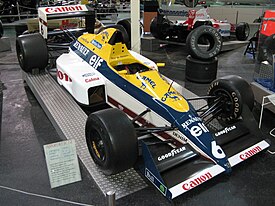Williams FW12
 |
|||||||||
| Category | Formula One | ||||||||
|---|---|---|---|---|---|---|---|---|---|
| Constructor | Williams | ||||||||
| Designer(s) |
Patrick Head (Technical Director) Enrique Scalabroni (Chief Designer) |
||||||||
| Predecessor | FW11B | ||||||||
| Successor | FW13 | ||||||||
| Technical specifications | |||||||||
| Chassis | Carbon fibre and honeycomb composite monocoque | ||||||||
| Suspension (front) |
1988: Active suspension 1988 / 1989: Double wishbones, pullrods |
||||||||
| Suspension (rear) |
1988: Active suspension 1988 / 1989: Double wishbones, pullrods |
||||||||
| Axle track |
1988: Front: 1,803 mm (71.0 in) Rear: 1,676 mm (66.0 in) 1989: Front: 1,803 mm (71.0 in) Rear: 1,600 mm (63 in) |
||||||||
| Wheelbase |
1988: 2,743 mm (108.0 in) 1989: 2,997 mm (118.0 in) |
||||||||
| Engine |
1988: mid-engine, longitudinally mounted, 3,496 cc (213.3 cu in), Judd CV, 76° V8, NA. 1989: mid-engine, longitudinally mounted, 3,493 cc (213.2 cu in), Renault RS1, 67° V10, NA. |
||||||||
| Transmission | Williams / Hewland 6 speed manual | ||||||||
| Weight | 500 kg (1,100 lb) | ||||||||
| Fuel |
1988: Mobil 1989: Elf |
||||||||
| Tyres | Goodyear | ||||||||
| Competition history | |||||||||
| Notable entrants | Canon Williams Team | ||||||||
| Notable drivers | 5. 5. 5. 5. 6. |
||||||||
| Debut | 1988 Brazilian Grand Prix | ||||||||
|
|||||||||
| Constructors' Championships | 0 | ||||||||
| Drivers' Championships | 0 | ||||||||
The Williams FW12 was a Formula One racing car used by the Williams team for the 1988 season. An updated version, the FW12C, was used for 12 of the 16 races of the 1989 season. The FW12 was Williams's first naturally aspirated car since the FW08C used in the 1983 season.
In its original guise the FW12 featured a Judd CV 3.5 V8. In 1988 the car was unsuccessful for Williams after two years of domination with the FW12's predecessor, the FW11 and FW11B, through use of the all-powerful V6 Honda turbo engine. Williams actually had an existing contract to continue using the Honda engines in 1988. However, the team's refusal to dump Nigel Mansell and replace him with Honda's test driver Satoru Nakajima (an F1 rookie in 1987 with Lotus) for the 1986 season, as well as Honda being reportedly unhappy with Williams management for allegedly not honouring the number one driver status of Nelson Piquet's contract which contributed to both Piquet and Mansell losing the 1986 Drivers' Championship to McLaren's Alain Prost, saw the relationship between Honda and the team sour and the Japanese giant pulled out of the contract, announcing at the Hungarian Grand Prix a three-year deal to supply their engines to McLaren from 1988.
Early in the season the FW12 was described by both Nigel Mansell and Riccardo Patrese as being pathetically slow in a straight line. The facts backed up the drivers' claims. In qualifying for the opening race of the season in Brazil, despite Mansell qualifying a surprising second on the grid, the FW12 was only timed at 265 km/h (165 mph) on the Jacarepaguá circuits 900 metre long back straight. This compared to the over 290 km/h (180 mph) recorded by McLaren and Lotus with their Honda turbo engines. That speed deficit, along with trouble from the reactive suspension system, saw only one point scored before the mid-season British Grand Prix, when Riccardo Patrese finished 6th in Monaco. For his part, Mansell, who had won 11 races though 1986 and 1987 - more than any other driver, failed to finish the first seven races of the 1988 season.
...
Wikipedia
